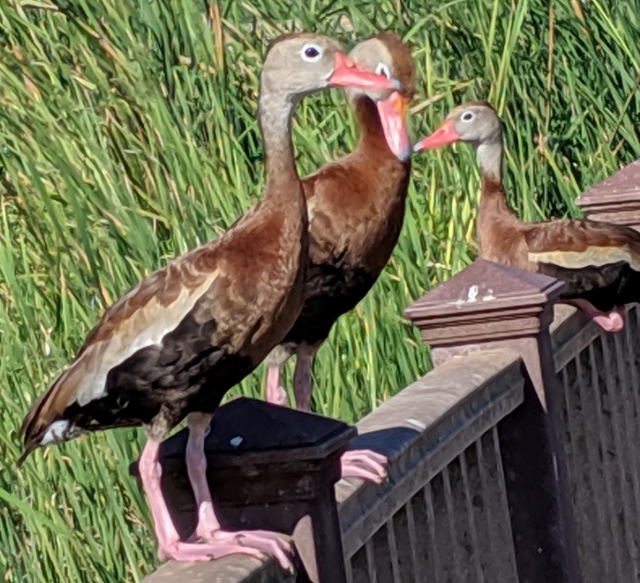
We’re surrounded. These perky, red-billed, red-footed black-bellied whistling ducks— like cats—think they belong everywhere, it seems.
They perch with their buddies on rooftops, fences and telephone poles, and, in the summer, they shepherd their fuzzy black-and-white striped children down irrigation canals. They even paddle in our swimming pools. Then, near sunset, they rise en masse for an evening of foraging—heads and feet lowered, bodies hunched, with long red legs and necks extended, calling each other constantly, their bright colors an iridescent pinkness in the setting sun.
The black-bellied whistling duck (Dendrocygna autumnalis), formerly called the black-bellied tree duck, lives year-round in the Rio Grande Valley, but, according to Javier Gonzalez, Naturalist Educator at South Padre Island Birding, Nature Center and Alligator Sanctuary, we “see the bulk of them during the summer when they come into our freshwater wetlands to nest and raise babies.”
These ducks also nest in Mexico, Central and South America. Adaptive to human activities, their range has expanded northwards as far as Dallas, Louisiana, Florida, and even Arizona and California. Ducks from cooler areas may flock to the Valley during autumn and winter, increasing our numbers.
The duck’s genus name “Dendrocygna” derives from Latin “dendro” for trees and, interestingly, Latin “cygna” for swan, although “anas” is the Latin word for duck. Its species name “autumnalis” means autumn.
Black-bellied whistling ducks occupy a variety of habitats, including riparian forests (those near water), as well as residential areas. They flock in open fields, shallow ponds and ditches.
This decorative duck has a rust-colored breast, a black belly, rump and tail and a gray face with a white circle around its eyes. Its bill and legs are red or coral-colored, and a white wing-patch appears as a wide stripe during flight. The sexes look alike. Immature ducks have brown and gray feathers and a dark gray bill.
Whistling shrilly, the ducks ascend in flocks, usually at dusk, to forage in lawns, fields and golf courses for a variety of plant matter, including grass seeds and sorghum grain. Gonzalez said he has “often seen large flocks of them at grain silos” in the Valley. Also, they wade and dabble in shallow freshwater, skimming the surface or, with heads submerged and tails up, feeding on shallow plants and aquatic invertebrates. They also eat, to a lesser degree, insects, spiders and snails. Ducks often roost on islands and sandbars. Flocks can number as many as 1,000 ducks.
Black-bellied whistling ducks, forming their initial long-term pair bonds in the winter, breed during their first year, usually in late March through October. Males compete for mates, nipping, chasing each other, stretching their necks forward and opening their bills. In courtship, the ducks stretch their necks sideways, dip their bills and flick water over their backs.
Both parents select a nesting site, often near fields where they can forage. The female may lay eggs on the ground beneath overhanging foliage, scraping out a bowl of grasses. The ducks also nest in tree cavities five to twelve inches high, near broken branches or rotting trunks, often next to soft plants, which offer the ducklings a comfortable landing spot. Ducks readily use nest boxes—which may, in part, account for their population increase in the U.S.
The ducks frequently nest in colonies, and, especially during droughts, females may lay their eggs in others’ nests, known as “dump nests”, which contain as many as 100 eggs; foster parents care for all nestlings present. Raccoons, opossums and snakes may devour eggs. Parents may abandon a nest disturbed by predators, bees, ant or other ducks.
The 12 to16 whitish eggs hatch in from 25 to 30 days. Ducklings are precocial, or able to care for themselves almost immediately. Heeding their mother’s call, nestlings jump out of the nest and follow her to water. Ducklings remain with their parents, who may protect them from predators like catfish, bass and gar, as well as fire ants, until able to fly.
Local naturalist Jim Campbell, relating his struggles with extracting ducklings from his swimming pool, advised that one not “get between mama and papa black-bellied whistling ducks and their babies.” The parents, whom he called “protective and fearless,” attacked him three times one day, as the babies were “insistent on swimming in the pool.” The ducklings, trapped inside, exited the pool only when Campbell “headed them down” several times to a lower side from which could scramble out. Seeing all nine ducklings dive to the pool’s shallow bottom, Campbell wondered if they dove for play or in search of food. When he opened a drain in which one duckling was trapped, it dove away to escape him.
Black-bellied whistling ducks, according to the North American Breeding Bird Survey, are thriving, having increased about six percent from 1966 to 2014. Nevertheless, they require suitable habitats and good water quality. Some ducks in Mexico in the 1980s tested for high levels of DDT and other harmful substances, and ducks can also die of lead poisoning and from being tangled in fishing line. Also, as reported this September in the magazine Nature, North American birds, in general, have declined by 20% over the past 40 years, though waterfowl, looked after by hunting proponents, have suffered less.
Texans may hunt whistling ducks in season, but these are not popular game birds. One YouTube video, however, celebrated the tastiness of their thighs, offering instructions for frying them. Like other waterfowl, these ducks may be preyed upon by alligators and owls. They live from six to eight years.
Those wishing to attract these ducks to their yards may build nesting boxes or toss out millet or cracked corn.